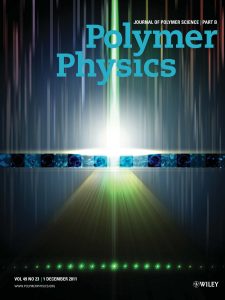
Electrical and Computer Engineering Assistant Professor Liang Dong’s paper titled “Multichannel Detection Using Transmissive Diffraction Grating Sensor” is featured on the December 2011 cover of the Journal of Polymer Science Part B: Polymer Physics.
In the paper, Dong and electrical engineering PhD students Peng Liu and Depeng Mao present a new transmissive diffraction grating pH sensor made of hydrogel that inherently detects range options and is highly sensitive.
“This research is focused on developing a new series of sensors having both multiple detection range options and high sensitivity. In many sensing situations, especially sensing environmental conditions in field, concentration range of a target species is unknown, so we prefer a sensor with a wide detection range covering all possible concentrations.”
According to Dong, the problem is wide detection range often compromises sensitivity of a sensor. “In many other situations, especially in laboratory testing, concentration range of an analyte is often known, so we test samples using a sensor for this specific concentration with high sensitivity. But a new problem comes obviously: this sensor cannot work in other concentration ranges.”
Dong explains that generally, a tunable sensor with multiple detection ranges requires nontrivial tuning mechanisms, such as using complex micro-electro-mechanical systems to adjust material properties, device structures, and bias conditions. He adds that another approach is to use different sensing elements in a sensor system with each element committed to a specific detection range, which may cause considerable complexity in design, fabrication, and integration of different sensing elements.
“Our multichannel sensor approach is much simpler and more cost-effective. It does not need any complex tuning mechanism or use multiple sensing elements. Our sensor system consists of a cheaper laser pointer, an array of hydrogel microstrips, and a photodetector. A transmitted light beam from the grating forms diffraction patterns composed of light spots. The width of the hydrogel microstrips changes with changing environmental pH conditions, causing to change light intensity or brightness at each diffracted light spot. We found that each diffracted spot actually responds differently to the same pH change and each spot has a specific detection range of pH with high sensitivity,” Dong says.
Dong adds that the same device concept can be adopted to develop new sensors for detecting other physical, chemical, and biological parameters. “The only change one needs to make is replacing pH-sensitive hydrogel with other stimuli-responsive hydrogels. Various types of hydrogels are available that are specifically sensitive to parameters such as temperature, pH, light, electric field, ionic strength, glucose, and antigen-antibody binding.
The research was supported by the National Science Foundation, the U.S. Department of Energy’s Ames Laboratory, and the Chinese Scholarship Council.